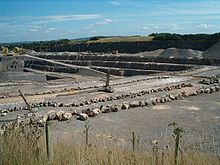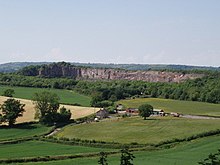The Mendip Hills, (Mendips) in northern Somerset, are the most southerly Carboniferous Limestone uplands in Britain.


The Mendips comprise three major anticlinal structures, each with a core of older Devonian sandstone and Silurian volcanic rocks. The latter, after crushing, is use in road construction and concrete. Devonian Sandstone is visible around Black Down and Downhead. Carboniferous Limestone, dominates the hills and surround the older rock formations.[1] An outcrop of basalt is also quarried at Moon's Hill.
For centuries the stone of the Mendips, and the Cotswolds to the north, have been used to build the cities of Bristol and Bath, and many Somerset towns. As stone transportation is expensive, the Mendips, and Leicestershire, are important as the nearest sources of hard stone for London and the South East.
The Mendip quarries produce twelve million tonnes of stone a year, employ two thousand people, and have an annual turnover of £150m.[2] Five million tonnes of stone per year is transported by Mendip Rail.
Active quarries
edit| Name | Location | Map | owners/operators | Notes |
|---|---|---|---|---|
| Batts Combe Quarry | Cheddar | ST460550 | Hanson Aggregates | |
| Callow Rock Quarry | Cheddar | ST442558 | Bardon Aggregates | |
| Colemans Quarry | Holwell near Nunney | ST726452 | Aggregate Industries | |
| Doulting Stone Quarry | Doulting | ST648436 | Independent business. | |
| Dulcote Quarry (closed) | Dulcote near Wells | ST565445 | Foster Yeoman – Bardon Aggregates | |
| Halecombe | Leigh-on-Mendip | ST697474 | Tarmac | |
| Gurney Slade Quarry | Gurney Slade between Binegar and Holcombe | ST626497 | Morris & Perry (Gurney Slade) Ltd | |
| Moon's Hill Quarry | Stoke St Michael | ST665460 | John Wainwright & Co Ltd | Geological Site of Special Scientific Interest |
| Torr Works (Merehead) | East Cranmore / Downhead | ST695446 | Foster Yeoman – Aggregate Industries | |
| Whatley Quarry | Whatley | ST731479 | Hanson PLC |
Disused quarries
edit- Barnclose Quarry
- Brambleditch Quarry
- Cliff Quarry, Compton Martin
- Cloford Quarry — geological Site of Special Scientific Interest
- Cloud Quarry
- Cook's Wood Quarry — geological Site of Special Scientific Interest
- Draycott Quarry
- Emborough Quarries — geological Site of Special Scientific Interest
- Fairy Cave Quarry
- Hobbs Quarry — geological Site of Special Scientific Interest
- Holwell Quarries — geological Site of Special Scientific Interest
- Shipham Quarry
- Underwood Quarry (near Wells)
- Viaduct Quarry — geological Site of Special Scientific Interest
- Waterlip Quarry
- Westbury Quarry
- Windsor Hill Quarry — geological Site of Special Scientific Interest
References
edit- ^ "The Aggregate Landscape of Somerset: Predicting the Archaeological Resource" (PDF). Retrieved 14 February 2007.
- ^ "What is the significance of quarrying to the local economy?". Retrieved 11 November 2010.